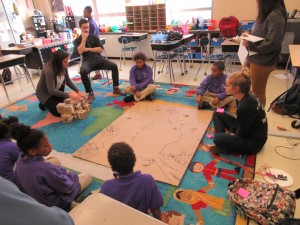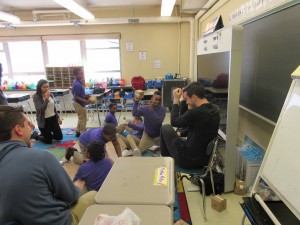Field Work : 3rd Visit to School 2
Dec 15th, 2015 by jungg
November 9th, 2015 : Third Visit


As designers, there are many things to be learned by testing an idea. After working with the fifth grade students from School 2 in Troy, New York twice, our team of designers (James Cazzoli, Rachel Dyment, Logan Rotolo, Gina Jung, and myself) came up with a third prototype that combined all of the positive outcomes of our previous prototypes and attempted to fix the negative ones. That being said, we continued to use the concept of an island that we delivered on our second visit since that proved to be of interest to the children and also allowed us to be flexible with our design. One of our goals was to choose a concept that would make it easy to alter after testing. Our team made use of this flexibility going from the second device to the third and hope to the same for our fourth prototype.
Drawing from our first visit, we also wanted to further develop the idea of making connections. That is, with our first prototype, we noticed that for a lot of students it was difficult to relate concepts that were similar or connected. The teachers also emphasized the need to develop this technique particularly in math and writing. Principally in math, students would understand how to solve a specific problem but when given a problem similar to that one, they had no idea how to solve it. Initially, our team attempted to make a game that would test what sort of connections the children inherently made. However, we retracted from this idea because we thought it would be more useful to try to work with the connections we already know they were struggling to make.
As a result of our research, and our desire to make something tangible and fun for the children, we came up with a game where children used cardboard boxes with numbers 1-9 and addition, subtraction, multiplication, and division signs scattered randomly. The goal of the game was to use competition to motivate the children to apply and understand order of operations. To do this we created an island with a dragon present in the lake. Each group of kids had to use five blocks with three numbers and two symbols to get to the number assigned. Once the team solved for the number an led light would like up indicating that the canon in the island was a bit more charged. Once a team lighted up four lights, the canon was fully charged and that meant the team had one. As a reward for the winning team, the children got to throw the boxes to James who represented the dragon.
There were many positive outcomes that resulted from our game. The children were really excited and engaged in the math. One of the girls even continued to repeat PEMDAS and write it down in her notebook although we never mentioned PEMDAS or even order of operations. This result was very rewarding. On the other hand, there is definitely some room for improvement. During our game, many of the children would fight over the boxes. Additionally, it became apparent that some kids where quicker with the math than others and made it difficult for the slower kids to participate. Finally, all though our reward system was very effective in motivating the kids it was a bit too rowdy and aggressive. These pros and cons have been analyzed and taken into consideration by our design team and will be used as data to come up with an even better prototype for our next visit.